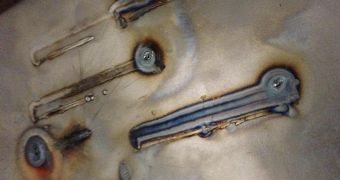I've seen many bizarre things, even if most of them were fictional, but sometimes, it's the innocuous stuff that gets to you. Admittedly, 3D printing, robotics and welding aren't exactly innocuous to the common man, but if you're reasonably up to date on technology, they more or less are.
After all, 3D printing technology is quickly becoming the holy grail of manufacturing techniques, toy makers, fashion designers and, most importantly, doctors all around the world. It's even putting inflatable houses on the moon, if you can believe it.
It all started when 3D printers gained the ability to build items, or grow them as the case may be, from things other than plastic.
First came resin, the type that gets bombarded with light and made to “grow” into whatever 3D model you're using as a template.
Then came wax (or, well, variations of it) and, eventually, metal became a material usable in 3D printing.
It wasn't too scary at first. Metal 3D printers were little more than huge, bulky, glorified welders. Proof of concept really.
Now, though, a man has almost built a cheap, €600 / $800 3D printer that can create things from steel and titanium.
It wouldn't be that strange, if not for something else that the 3D printing community came up with: the Maker's Empire app.
Anyone can bend metals to their will now, even kids
I might be overdoing it with the drama, but if anyone ever combines that new, affordable metal 3D printer with the Maker's Empire app, it will probably change the hobbies and priorities of everybody, even primary school pre-teens.
You see, the Maker's Empire app allows you to easily control a 3D printer from your tablet. Now imagine a naturally curious kid whose father is a mechanic, or just likes to tinker in his garage or shed with, well, stuff.
The father decides to buy a 3D printer, a metal 3D printer. Really, getting the new app would be a no brainer, especially since it will probably be free, or cost a pittance compared to the printer itself.
It would open up a new can of possibilities for the man, his kid, and the man and his kid as a single whole (awesome bonding opportunities, among other things) because there would be absolutely no training involved whatsoever in the creation of mechanical parts, tools and gears.
Even children that don't know their numbers all that well could go ahead and have something printed from molten steel.
The implications
It all kind of puts in perspective just how the world has changed. Until a couple of years ago, you needed a good grounding in general science before you could even think of engineering something.
Also, manufacturing facilities had (and still have) production lines designed to make only one type of device or part, over and over and over.
Creating anything even remotely unusual, like a custom component for a mechanical clock or a gear for a bot, either needed you to change how the whole assembly line operated, or build the thing by hand.
The last option could take days or weeks, and usually needed the craftsman to have years of experience in, for this case, metalworking. And the first sample usually didn't turn out just right, leading to even more time wasted.
Now, none of that applies anymore. If you need a particular component for some totally new invention or weird toy for your kid, you can make it in as little as half a day.
Moreover, your eight-year-old kid can just use a basic 3D program to make a model, then use the tablet app to tell the printer to make whatever they need for a school science project. All with minimal, if any, input from you.
It's just a step away from how a 10-year-old girl assembled an awesome 3D printed prosthetic hand for a science fair.
The future...
...Is now, as they say. I just hope that nothing disastrous happens because of this amazing progress. Like, I don't know, someone using a metal 3D printer to create metallic variations of those 3D printed guns that have the world authorities in a tizzy even now, when they're made of only plastic.

 14 DAY TRIAL //
14 DAY TRIAL //